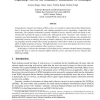Free Online Productivity Tools
i2Speak
i2Symbol
i2OCR
iTex2Img
iWeb2Print
iWeb2Shot
i2Type
iPdf2Split
iPdf2Merge
i2Bopomofo
i2Arabic
i2Style
i2Image
i2PDF
iLatex2Rtf
Sci2ools
DEBU
2002
2002
Exploiting Web Service Semantics: Taxonomies vs. Ontologies
Comprehensive semantic descriptions of Web services are essential to exploit them in their full potential, that is, discovering them dynamically, and enabling automated service negotiation, composition and monitoring. The semantic mechanisms currently available in service registries which are based on taxonomies fail to provide the means to achieve this. Although the terms "taxonomy" and "ontology" are sometimes used interchangably there is a critical difference. A taxonomy indicates only class/subclass relationship whereas an ontology describes a domain completely. The essential mechanisms that ontology languages provide include their formal specification (which allows them to be queried) and their ability to define properties of classes. Through properties very accurate descriptions of services can be defined and services can be related to other services or resources. In this paper, we discuss the advantages of describing service semantics through ontology langua...
| Added | 18 Dec 2010 |
| Updated | 18 Dec 2010 |
| Type | Journal |
| Year | 2002 |
| Where | DEBU |
| Authors | Asuman Dogac, Gokce Laleci, Yildiray Kabak, Ibrahim Cingil |
Comments (0)

